The division table is simple. Parents need to be patient and tact towards the child.
Content
- How to quickly learn the division table?
- Division and multiplication table - simulator
- Video: Golden arithmetic - the most cool program for training oral account !!!
- Video: division grade 2 presentation
- Division table by 2
- Division table by 3
- Division table by 4
- Division table by 5
- Division table by 6
- Division table by 7
- Division table by 8
- Division table by 9
- Game - division table
- Video: mental arithmetic. Division. Lesson No. 13
- Video: Developing cartoon mathematics study by heart of the multiplication and division table by 2
- Video: Mathematics Grade 6. Multiplication and division of positive and negative numbers.
- Video: Division into a column
- Video: Mathematics Grade 3. Two methods of division
- Mathematics is a complex subject for many schoolchildren. The subject of division is taught in the third grade. One or two lessons are assigned to it. During this time, the child must have time to master the material
- Someone misses the lessons due to illness, while others are simply difficult to remember the division table in one day. Therefore, it is necessary to deal with such children at home - this will help to catch up and catch up with peers
How to quickly learn the division table?
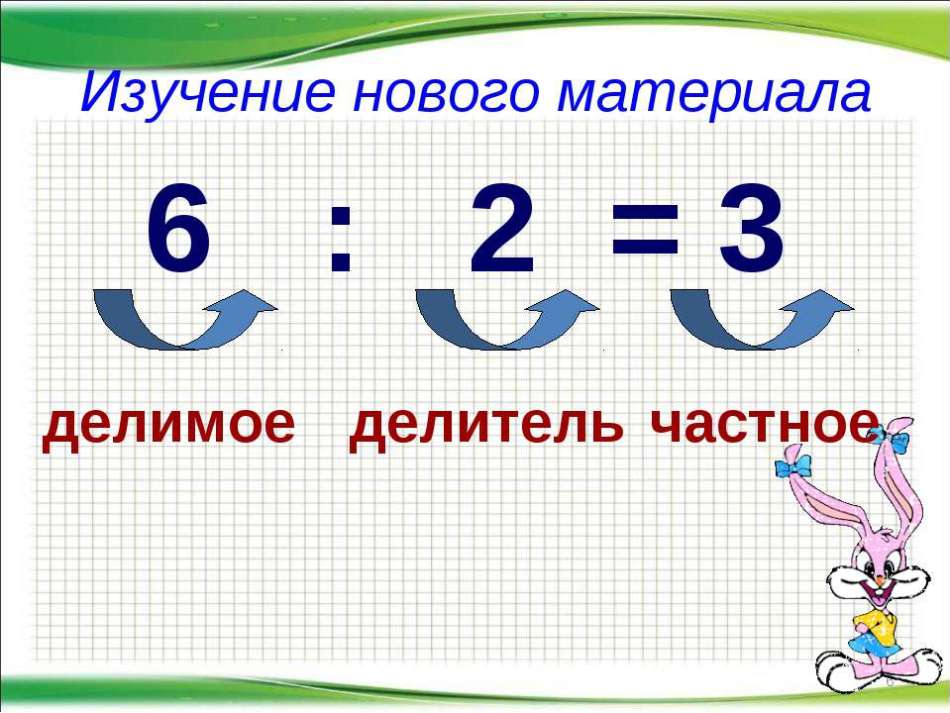
Important: try to deal with your child in a playful way. He will be interested, which means that classes will be fascinating and without much effort.
Tip: To make the child easily teach the division table, he must know thoroughly multiplication table. Therefore, check the skills of multiplication and if there are gaps, repeat the material passed.

So, how to quickly learn the division table:
- No need to force the baby to "cram" actions. He must understand the algorithm
- Use coins or counting sticks to explain. With the help of these objects, the child will be able to not only learn division, but also develop a small motorics of the handswhich is well affected by brain activity
- Start teaching the division table from 9. When you reach 5, the complex half of the table will be learned - the rest will be remembered easily
- Praise the baby and encourage him with your favorite sweets, because he tries
- Classes daily. This will help to develop visual memory
- At first, it will be difficult for the child to remember actions, but over time he will give the correct answer
- Train memory The baby even during a walk. For example, let him consider how many sweets were bought for each family member
Division and multiplication table - simulator
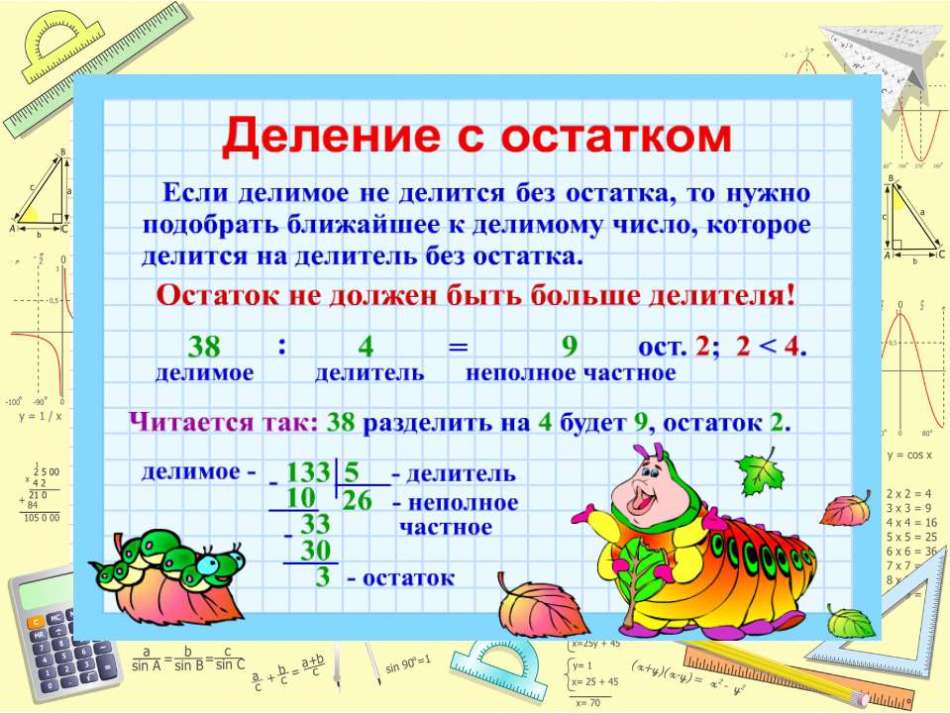
Important: special programs help to study the division and multiplication table. You can hang a poster with large printed numbers in these actions on the wall.
Such a simulator is a clear example. The child can always turn to him for help when it is necessary.
There are different programs that help gain oral account skills.
Video: Golden arithmetic - the most cool program for training oral account !!!
Video: division grade 2 presentation
Division table by 2

Tip: Do not conduct additional classes with your child at home if he feels bad or simply capricious. Wait a couple of days, and then continue to engage.
Division table by 2:
0: 2 \u003d 0 (0 divided by 2, it turns out 0)
2:2=1 (2 divide by 2, it turns out 1)
4:2=2 (4 divide by 2, it turns out 2)
6:2=3 (6 divide by 2, it turns out 3)
8: 2 \u003d 4 (8 divide by 2, it turns out 4)
10:2=5 (10 divide by 2, it turns out 5)
12:2=6 (12 divide by 2, it turns out 6)
14:2=7 (14 divide by 2, it turns out 7)
16:2=8 (16 divide by 2, it turns out 8)
18:2=9 (18 divide by 2, it turns out 9)
20:2=10 (Divide 20 by 2, it turns out 10)
Division table by 3
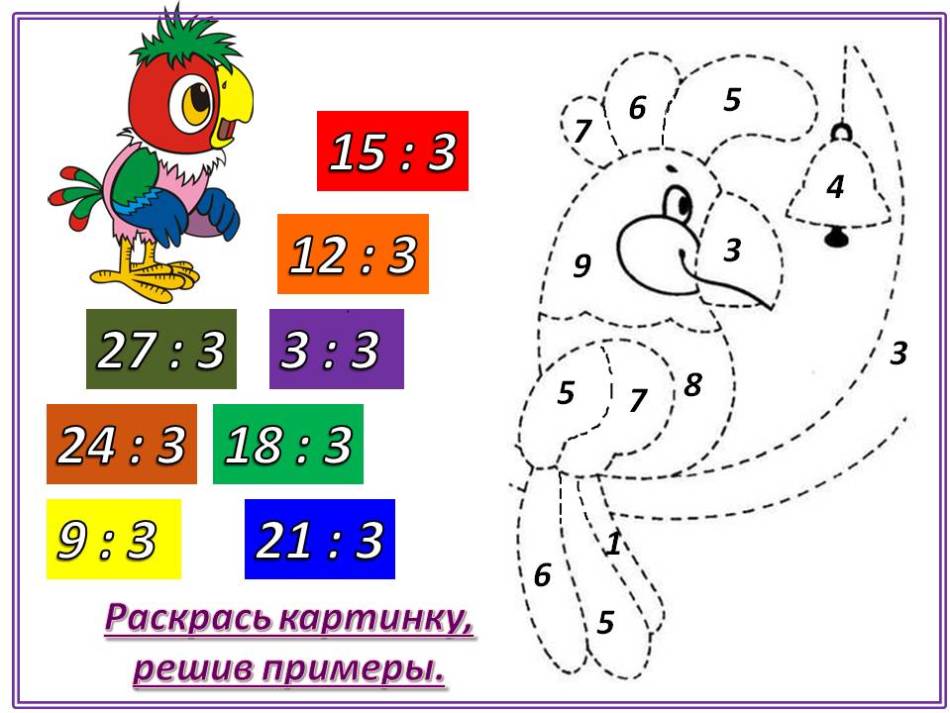
Important: explain to the child that when dividing zero into any number, the result will be zero. You can’t divide into zero!
The division is a little more complicated than multiplication, but no mathematical task is also done without this action. Therefore, the baby must learn the theme of “division”, so that later it would be easy for him to solve any examples and problems in mathematics.
Division table by 3:
0: 3 \u003d 0 (0 divided by 3, it turns out 0)
3:3=1 (3 divide by 3, it turns out 1)
6:3=2 (6 divide by 3, it turns out 2)
9:3=3 (9 divide by 3, it turns out 3)
12:3=4 (12 divide by 3, it turns out 4)
15: 3 \u003d 5 (15 divide by 3, it turns out 5)
18:3=6 (18 divide by 3, it turns out 6)
21:3=7 (21 divide by 3, it turns out 7)
24:3=8 (24 divide by 3, it turns out 8)
27: 3 \u003d 9 (27 divide by 3, it turns out 9)
30: 3 \u003d 10 (30 divide 30, it turns out 10)
Division table by 4
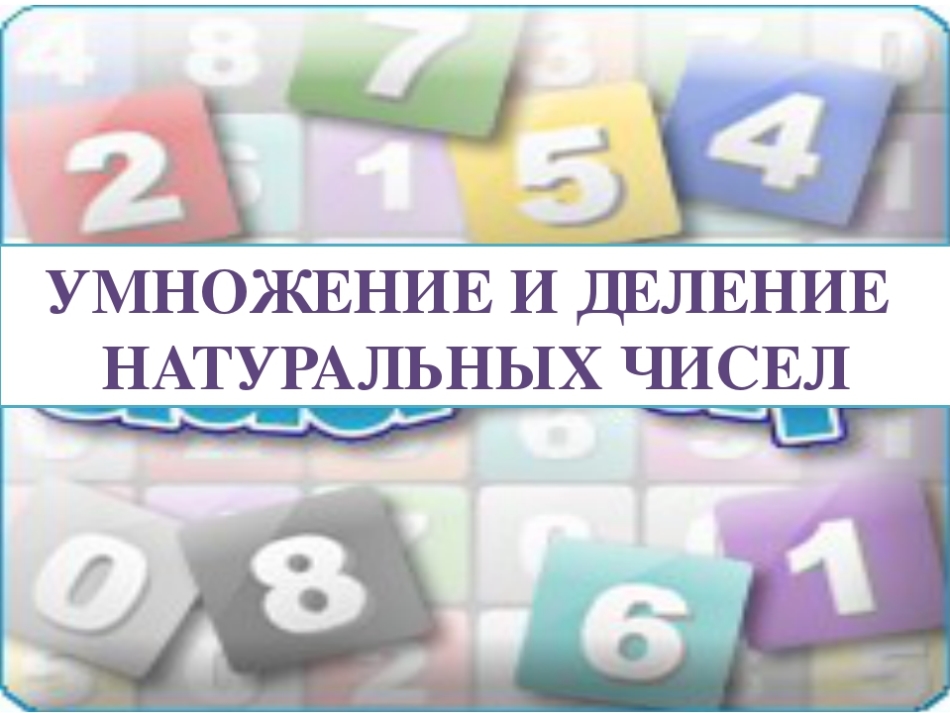
Four division is an easy action for a student who knows well multiplication table And the division table by 2 and 3. The child can even calculate the result in the mind, if there is no mood to memorize actions.
Division table by 4:
0:4=0 (0 divided by 4, it turns out 0)
4:4=1 (4 divide by 4, it turns out 1)
8:4=2 (8 divide by 4, it turns out 2)
12:4=3 (12 divide by 4, it turns out 3)
16:4=4 (16 divide by 4, it turns out 4)
20:4=5 (Divide 20 by 4, it turns out 5)
24:4=6 (24 divide by 4, it turns out 6)
28:4=7 (28 divide by 4, it turns out 7)
32:4=8 (32 divide by 4, it turns out 8)
36:4=9 (36 divide by 4, it turns out 9)
40:4=10 (40 divide by 4, it turns out 10)
Division table by 5
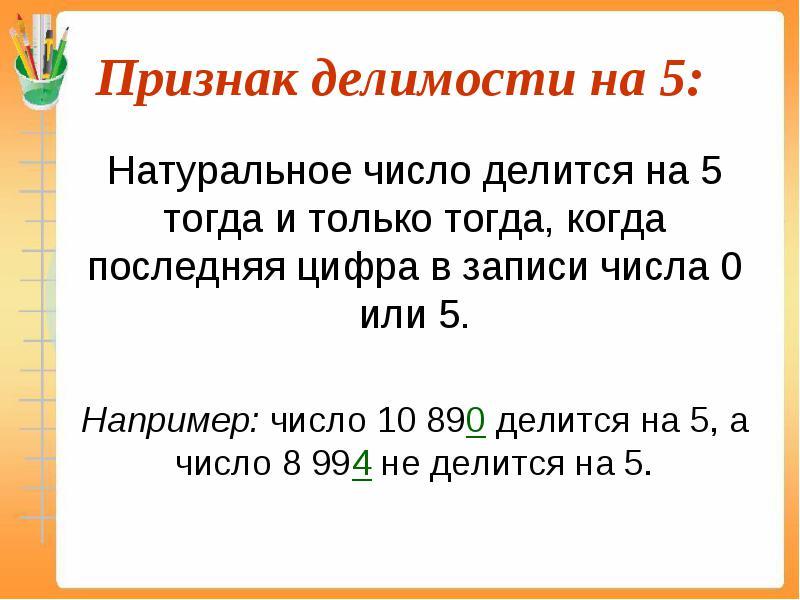
Division by 5 is simple and easy. It is remembered easily, like the multiplication table by 5.
Division table by 5:
0:5=0 (0 divided by 5, it turns out 0)
5:5=1 (5 divide by 5, it turns out 1)
10: 5 \u003d 2 (10 divide by 5, it turns out 2)
15:5=3 (15 divide into 5, it turns out 3)
20: 5 \u003d 4 (20 divide into 5, it turns out 4)
25:5=5 (25 divide by 5, it turns out 5)
30: 5 \u003d 6 (30 divide 30, it turns out 6)
35: 5 \u003d 7 (35 divide by 5, it turns out 7)
40: 5 \u003d 8 (40 divide by 5, it turns out 8)
45: 5 \u003d 9 (45 divide by 5, it turns out 9)
50: 5 \u003d 10 (Divide 50 by 5, it turns out 10)
Division table by 6

If the division into 6 child is still difficult to give, then let him try share a column. The more he will deal with dividing into a column, the faster the baby will understand the division algorithm.
Division table by 6:
0:6=0 (0 divided by 6, it turns out 0)
6:6=1 (6 divide by 6, it turns out 1)
12:6=2 (12 divide into 6, it turns out 2)
18:6=3 (18 divide by 6, it turns out 3)
24:6=4 (24 divide by 6, it turns out 4)
30:6=5 (30 divide 30, it turns out 5)
36:6=6 (36 divide by 6, it turns out 6)
42:6=7 (42 divide by 6, it turns out 7)
48:6=8 (48 divide by 6, it turns out 8)
54: 6 \u003d 9 (54 divide by 6, it turns out 9)
60:6=10 (60 divide by 6, it turns out 10)
Division table by 7

The most difficult process begins - memorizing division by 7.
Tip: Explain to the child that he only has to learn the division by 7, 8 and 9, and the division by 10 is a simple action for memorization.
Division table by 7:
0: 7 \u003d 0 (0 divided into 7, it turns out 0)
7:7=1 (7 divide into 7, it turns out 1)
14:7=2 (14 divide into 7, it turns out 2)
21:7=3 (21 divide into 7, it turns out 3)
28:7=4 (28 divide into 7, it turns out 4)
35:7=5 (35 divide into 7, it turns out 5)
42: 7 \u003d 6 (42 divide into 7, it turns out 6)
49:7=7 (49 divide into 7, it turns out 7)
56:7=8 (56 divide by 7, it turns out 8)
63: 7 \u003d 9 (63 divide into 7, it turns out 9)
70:7=10 (70 divide into 7, it turns out 10)
Division table by 8

Important: highlight a couple of days to memorize division by 8. This will help the child understand the algorithm of action and learn the material.
Division table by 8:
0:8=0 (0 divided by 8, it turns out 0)
8:8=1 (8 divide by 8, it turns out 1)
16:8=2 (16 divide by 8, it turns out 2)
24:8=3 (24 divide by 8, it turns out 3)
32:8=4 (32 divide by 8, it turns out 4)
40:8=5 (40 divide by 8, it turns out 5)
48:8=6 (48 divide by 8, it turns out 6)
56:8=7 (56 divide by 8, it turns out 7)
64:8=8 (64 divide by 8, it turns out 8)
72:8=9 (72 divide by 8, it turns out 9)
80:8=10 (80 divide by 8, it turns out 10)
Division table by 9
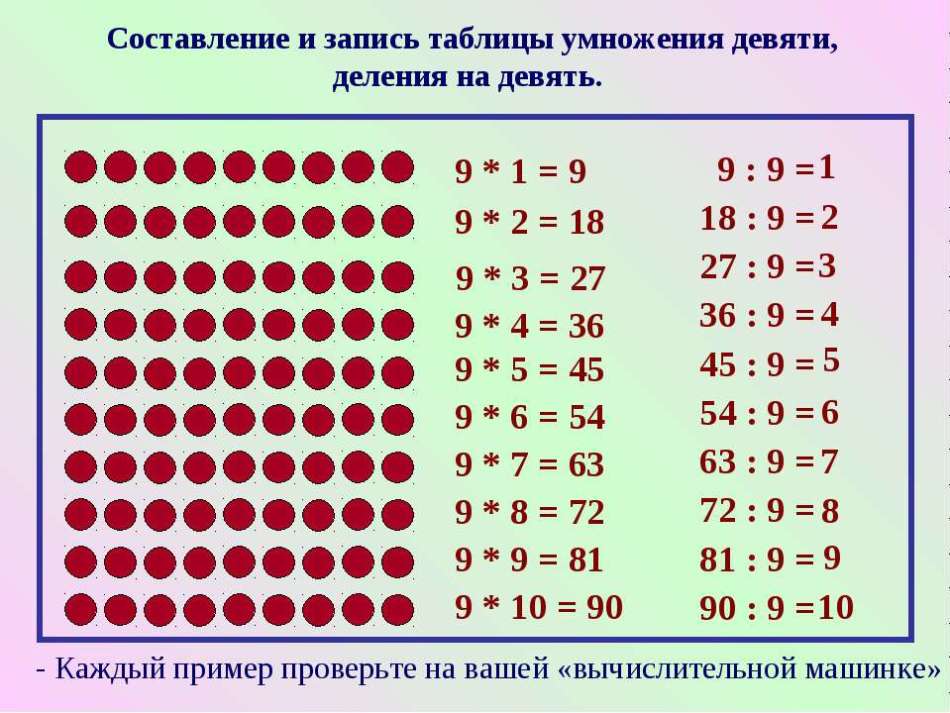
One of the most difficult actions in the division table is the division by 9. Many children quickly understand these examples, while others need time.
Important: be patient and you will succeed.
Division table by 9:
0:9=0 (0 divided by 9, it turns out 0)
9:9=1 (9 divide by 9, it turns out 1)
18:9=2 (18 divide by 9, it turns out 2)
27: 9 \u003d 3 (27 divide by 9, it turns out 3)
36:9=4 (36 divide by 9, it turns out 4)
45:9=5 (45 divide by 9, it turns out 5)
54:9=6 (54 divide by 9, it turns out 6)
63: 9 \u003d 7 (63 divide by 9, it turns out 7)
72:9=8 (72 divide by 9, it turns out 8)
81:9=9 (81 divide by 9, it turns out 9)
90:9=10 (90 divide by 9, it turns out 10)
Game - division table
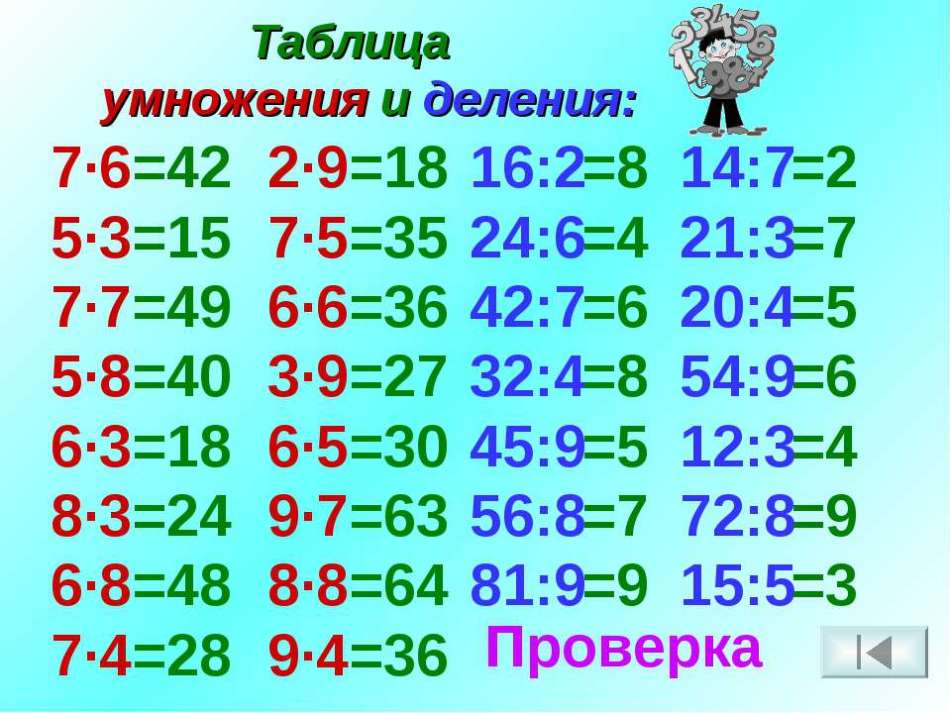
Currently, in specialized school stores, you can buy not only ordinary paper posters with a division and multiplication table, but also coloring for better memorization, electronic posters “Talking table”.
Also, the child’s division tables or just video clarification helps the child.
Video: mental arithmetic. Division. Lesson No. 13
Video: Developing cartoon mathematics study by heart of the multiplication and division table by 2
Video: Mathematics Grade 6. Multiplication and division of positive and negative numbers.
It often happens that the child cannot understand what parents want from him. If you turn on the video with the explanations of the division table from children or other adults, thoughts are immediately clarified and everything becomes clear.







